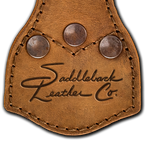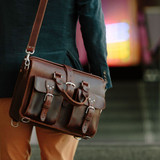The Four Keys to a High Quality Shoe
100 Year Warranty
Blessed is the great grandson who shares your shoe size
We're not saying ours are the highest quality shoes in the world, but we don't know how we could build them stronger and to last longer. Because of the extremely tight fiber structure of our leather and the strength of our materials, the tight tolerances of the time intensive Italian construction and the design that keeps the feet from banging the shoe apart from the inside, we rest well at night offering a 100 year warranty. Read the specifics here.
The Four Critical Areas of Quality
Just like a billion dollar submarine cannot truly be called high quality if it is built with a cardboard hatch, so a shoe cannot truly be called high quality if it is low quality in one of the four areas that defines quality. Shape, Materials, Construction and Design.
Quality and Rare Corrective Shape
After 4 months of wearing my first pair of anatomically correct shoes, my nearly 20 years of foot, knee and hip pain was gone. Our boots were built on that same form, which was the most consequential last in history, which we resculpted for elegance.
To learn about the last and WHY most shoe shapes are the root cause of so much foot, knee, hip and back pain, read here.
Quality Italian Old World Construction
Our shoes are made in a small family run workshop in Italy because they were the only ones we could find who still had the generational knowledge and techniques passed down within the family to work with such a rare asymmetrical and curved in last. Other high quality shops said those who knew how to build with such tight tolerances had since retired or died.
To learn every detail of WHY these old world techniques make shoes hold together and look better longer, click here.
Quality High Integrity Materials
Our leather is famous not only for the cow's tougher and tighter leather fiber structure, but because of the extra time consuming steps Italians take to tan it to be more durable. Our shoes will hold their form and look sharp for decades because of our materials. And our eyelets and shoelace hooks are second to none.
To learn, ad nauseum, WHY each material we chose is recognized as of the highest quality, click here.
Quality Distinguished Design
There is no single detail of the boot that draws out compliments from strangers, but it is the sum of all of the smaller details that make the whole shoe just seem artful, balanced and right, even down to the perfect color to fit the style. All of this affects the confidence of the wearer and enhances the perceptions of those who notice them walk in.
Read here WHY each detail was intentionally included, and why they took so many years to perfect.
The "Why" Behind Saddleback Boots - Two Reasons
First, regardless of if people buy our shoes or not, though we hope you do, I need to let the world know my pain story and the simple root cause of why most of the shoes of 50 million Americans are the main reason they visit the foot, knee, hip or back doctors each year and what it was about the shoes my friend made for me that caused all of my pain to go away.
I strongly believe that it is more impactful to show than to just tell what to look for and what to look out for in a shoe. If I can explain what I learned from old foot doctors, orthopedic surgeons and the most influential medical shoe designer of all time, in an easy to understand way, then most people will stop buying shoes that are bad for them, even expensive ones, and that will create a demand for shoes that are good for them, even low cost ones.
And secondly, by shining a bright spotlight on what a truly high quality shoe is, in extreme detail, light will also pull the curtain on so many expensive, yet low quality, shoes. That understanding.will open most people's eyes and reveal why they fall apart or look so dumpy in such a short time and that will create more of a demand for comfortable shoes that last a lot longer and that you'll actually want to wear for decades. Come nerd out with me. It can change your life.
Saddleback Boots FAQ
What makes Saddleback Boots different?
There are two big differences. The first will be a headscratcher to most people like it was to me before I understood the significance. But trust me on this one when I say... it is HUGE. What separates our leather boots from 99.99% of all other leather boots in the world is our 1912 1st generation Munson Last that one of the rare and great last sculptors of our generation adjusted to look so elegant.
The Munson Last is the most consequential shoe shapes in all of human history. It was created in 1912 by Dr. Munson for the U.S. military and changed the course of countless battles and the lives of millions of soldiers. It was so successful that hundreds of millions of boots were shaped on one of the six generations of the Munson Last. Any actual war footage you see of WWI, WWII, the Korean War and into the Vietnam era, they are wearing a Munson boot. It gave such an advantage to the army who used it that in WWII, the Germans actually sent spies into Great Britain to steal their Ammo Last, which was based on the Munson Last. "If it's so great", you ask, "then why don't more companies use the Munson last today?" Great question. To understand that answer and to nerd out with me about WHY our last is so significant, click here.
Secondly, our 100 Year Warranty makes us different. Who does that? It was such an easy decision for 4 excellent reasons. First, because of the extreme tightness and strength of every material we chose. Second, a small family run shop in Northern Italy constructs our shoes using many extra time consuming steps so they have the tightest of tolerances everywhere. Third, our shape secures the foot so it doesn't shift around and tear the shoe apart from the inside yet it gives ample room for the foot to spread when stepping on it. Fourth, last but not least, patternmakers are a dime a dozen, but a wise and experienced patternmaker who puts the shoe together with durability on the mind is worth their weight in gold.
Where are these boots made?
Every pair is handmade by master shoemakers in a family-run workshop in Italy. These craftsmen are trained by the man who was trained by his father who was trained by his father after World War II. They still use the old world methods and techniques of building shoes like they used to, but better — no shortcuts, no mass production. We couldn't find shoemakers in North America who can, or even know how to, do this level of time consuming old world construction with this level of finish quality.
Are these boots exclusive to Saddleback?
Yes. These aren’t white-labeled, rebadged or build on a borrowed or generic last. They were designed and engineered by Saddleback through and through, with the guidance of one of the most influential shoe designers in the world, all the way to down to the brogued cap on the tip of the toe. We also own the design patent on our elegantly sculpted proprietary shoe lasts.
What is the Munson Last?
A shoe last is the shoe form that leather wraps around to give each shoe it's particular shape. In 1908, the U.S. Army commissioned Dr. Munson, a relative of me, Dave Munson, to fix the huge problem of foot pain and damage in the military. He and his Shoe Board recorded that 38% of soldiers couldn't even finish a short 3 day - 16 mile march because of pain caused by their shoes.
Munson Last History
From 1908 to 1912, they x-rayed, examined and analyzed the feet of 2000 soldiers and then tested and tried thousands of different shoes on them. The Munson Last was tested again with hundreds of soldiers on a 120 mile 9 day march and 100% of them wearing shoes built on the Munson Last comfortably finished without a single foot problem. The result was a shoe that made the foot mimic the way a natural step is taken when barefoot. The Munson last was so successful that more shoes were made on it than on any other shoe last in history. Hundreds of millions of shoes were made for all U.S. soldiers from 1912 up to the Vietnam era.
There were six generations of the Munson last and ours is based off of the more elegant first to second generation versions, but sculpted to look more refined. To read about the genius of the last's anatomical shape and about the the build features that help build up foot strength or keep it strong, click here.
SIZING
How do they fit?
Our shoes run true to size because our sizing is simply based on the standard Brannock Device that every shoe store measures feet with. Sometimes we hear they are roomier in the toe box to start, but it soon feels normal as soon as the feet adjust back to their natural width. The Munson Last was shaped to form around the muscles and bones of the foot, so it will feel like a leather sock wrapped snugly around the heel and waist — but wider in the toe box and the big toe is not pushed toward the second toe. The reasons for the wide toe box and straight inner line from the heel to the tip of the big toe are many.
- To allow for the toe bones to get back into alignment with the foot bones.
- To allow room for the foot to naturally expand side to side when taking a step.
- To give room for the muscles, ligaments and tendons to spread back out to their natural state and strength.
- To increase stability and balance because of the wider tripod effect for the foot.
- When we take a step, our bodyweight starts off supported by the sturdy heel, then as the bodyweight moves forward our bodyweight is supported by the strong outer edge of the foot. When we lift our heel up a little, that's when the ankle rolls (pronates) the bodyweight toward the big toe to just the right place where all the toes, particularly the big toes, push down and launch the bodyweight forward. About then, our other foot swings forward and the outside of the heel hits the ground. With narrow toe boxes, the ankle doesn't feel the resistance of when to stop rolling the bodyweight toward the inside of the foot for the toes to launch the body forward because the toes and foot aren't spread out enough. Therefore, the ankle over-rolls (overpronates) the bodyweight and then all of the work of launching the body forward is left up to the big toe alone and a lot of time, the little toes aren't even touching the ground to help. Overpronation weakens the arch and makes it sag, which puts the whole body out of alignment and eventually causes pain.
Watch out for typical shoes that are designed so the foot has to form to shoe shape. That is so damaging.
Do they need a break-in period?
If a shoe has a painful break in period then that usually means that the shoe is slowly forming your foot to the shape of the shoe.
Most people say about our shoes that they are stiff when they put them on, but they have little to no break-in period and the shoes are comfortable minute one except for the stiffness. But after walking a couple of miles, they don't notice them all day. That's because our shoe was shaped to fit around the form of a healthy foot.
Some said it was uncomfortable initially at the snug waist of the shoe because their arch was flatter and needed to strengthen so it would lift up. But that went away as their arch exercised and strengthened back to normal. That happened to me too. People whose feet are used to the cushy life of padding, have soft muscles and low bone density, need to give it some time and wear them on and off until your feet build back up. The multiple layers of natural leather are great at absorbing shock. BTW, the doctors at Harvard and many other medical professionals say that minimal or NO PADDING is healthy and padding in shoes only magnifies the shock up to the knees, hips and lower back.
About 5% of pepole have high arches, which is the sign of a weak arch from launching off for the next step from your outside little toes. It's called underpronation or supination. The shoe may temporarily tight on the top part of your foot (instep) where the tongue of the shoe is. In these shoes, high arches flatten a little as the arch muscles get stronger from walking in the shoes. Lace the shoes by skipping holes to take pressure off of the instep.
My brother in law, Pete's heel hurts because it has no padding in the shoe like all shoes were made up until padding became common in the 60's or 70s. So, he needs to alternate shoes or wear padded heel or thicker socks until the heel builds up it's bone and muscle density. Our footbed is an extra thick slab of natural leather and so is the filling between it and the leather sole on the bottom. Almost all high quality bespoke shoes and fancy cowboy boots are made this healthy way and the leather is all of the padding most people need. The leather will be flat at first, but will eventually take in the natural indentations of your exact foot, along with the slap below that.
An old foot doctor of 30 years said his own boots have plenty of shock absorbsion in the stacks of leather for him to get through 10 hours a day on his feet. The former head of Harvard's School of Sports Medicine and Rehabilitation said that no or minimal padding is best for runners.
Do your shoes have arch support?
ABSOLUTELY NOT!!!. They are generally considered of the devil for normal people according by all medical professionals, except for some medical reasons. The only doctors who disagree are those making a significant portion of their income selling them to people who don't need them as a temporary fix to their pain, without trying to fix the reason the arch is weak and strengthen it back up like our shoes do. I strongly believe that is unethical and that they are breaking their Hippocratic Oath to help and not hurt.
Our shoes are designed with a tight snug arch that wraps down from above and is part of the difficulty of making these shoes. It requires special machinery and much skill to sew such a tight narrow arch like they used to do. Our leather arch wrap supports the arch by holding it up while still letting it expand and contract to exercise and get strong, while the rest of the shoe makes you walk naturally so your arch doesn't have to support too much weight.
Brigadier General Dr, Munson said that arch support from below doesn't allow the arch to expand and contract to stay strong and that's bad. It weakens the foot to not allow for the foot to move the way it's naturally supposed to. Click here to read more about no arch support.
What sizes do you offer?
These are US Sizes and we start at a Men’s 6 and offer half sizes all the way up to size 12 1/2., then 13, 14 and 15 without half sizes. For more info, check out the size chart below. A Men's size 6 is a Women's size 7 1/2. It is okay to get 1/2 size up, but you should never go 1/2 size down. We offer two widths which we call STANDARD and WIDE because most people don't know which width they are. Standard is the choice for C and D widths according to the Brannock Device that is used for measuring feet in shoe stores. A loose toe box is ideal. WIDE is for anything a hair above D and up to E 1/2. Most EEs will fit fine there. Every half size of length you go up is one 1/2 letter size of width. For example. If you order a 10 WIDE, that is a 10 E.5. If that is too tight for you, then order a 10 1/2 WIDE and that will add another 1/2 letter of width in there because of the 1/2 size up in length. So now the width is now EE.
What widths do you offer?
STANDARD is a narrower C or D width of foot. WIDE is for any width a hair over D and up to E 1/2. One of the damning characteristics of a bad and damaging shoe is a narrow toe box. There needs.to be plenty of room in the toe box so it you are going to make a mistake, go WIDE because the rest of the shoe is snug. One of the key characteristics of the famous Munson Last shape is that the toe box is wide to allow for the spreading out of the foot. That's one of the reasons it corrected almost all soldier's foot problems in the military.
What if I’m a EE? Go up a half size in length and choose WIDE and that will get you a half width wider too, which would be a EE. You can go up half a size in length no problem but can’t go down half a size. For example, If yo uare a 10C, then get a 10 STANDARD. If you are a 10D then get 10 STANDARD If you are a hair over a 10D up to a 10E 1/2 then get a 10 WIDE. If you are a 10EE, then go up to a 10 1/2 WIDE which is a half size in length longer which gets you a half size in width extra too which is a EE. Don't go up a full size of length longer unless you are going to stick toilet paper down there or something. But I wouldn't recommend it.
Three Reasons A Wide Toe Box is Good
You can't go wrong with extra space in the toe box for three reasons even if it feels a little spacious in there. You NEVER want your toes squeezed together because it weakens your foot. You'll wear thick woolen socks sometimes and because some people's feet spread out up to 1/2 inch extra when we step, especially if we have extra weight on our backs or our bellies. You want a little extra space there.
What if I have a high Arch?
Choose WIDE because the measurement of the width pertains to the overall circumference (gerth) of the widest part of your foot between your big toe knuckle and little toe knuckle. If it's still too tight on your instep (top part of your foot), then go up a 1/2 size in length and choose WIDE. You can tie your shoes by skipping every other hole to put less pressure on the instep. You main reason people develop a high arch because they underpronate (supinate) and that makes their arch muscles weak and they go high for some reason. Your arch muscles should strengthen in our shoes and that means your high arch will likely go back to normal and your foot will lengthen a little.
What if I order the wrong size?
DO NOT walk around in your shoes when you try them on because the sole polish comes off EASILY. Stand up on the carpet or on a blanket ONLY. They'll be stiff for the first two miles of walking, but comfortable. You'll know by just standing there if they're too tight or not, so you won't need to walk around. YOU CANNOT RETURN THEM IF THE SOLE IS SCUFFED UP BECAUSE YOU WALKED AROUND IN THEM. because what would we do if hundreds of people did that and sent them back scuffed? We would have a used shoe company.
PLEASE PLEASE PLEASE go to any shoe store or big store like Academy Sports that sells shoes and they'll have a BRANNOCK DEVICE to measure your feet. You will save so much time not returning your shoes for the correct size. We have calibrated our shoes to that device which is the standard around the world. Please don't just guess because a large study showed that 84% of soldiers in the military chose the wrong size. No worries if you do guess and get it wrong — we offer easy exchanges. See our Exchange section below for details.
PRODUCT
What kind of leather is used?
We use full grain (the toughest and most natural), vegetable-tanned leather that is waterproof because of their proprietary blend of natural fats and oils they impregnate it with for 2 or 3 days at the tannery. It is considered among the very best tanneries in Italy for this kind of leather. It’s the strongest, most beautiful leather we could find. This kind of leather is the best for leather pieces that get constant stress.
What kind of soles do they have?
From heel to toe, these boots have thick and tough full grain leather soles that are tanned the time consuming way to Italian standards for durability and comfort. They’re built with a welted construction so any shoe repairman can easily replace them. The heel has a durable rubber edge on it for traction. This is the same type of sole high quality boots and shoes are almost always made with.
Are the boots waterproof?
There could not be a shoe that water would have a tougher time getting into than ours. But to say they are technically waterproof, we would need to treat the leather with some sort of synthetic silicon in the tanning process. Our leather scoffs at water. It doesn't hurt it. The way we attach the upper part of the leather to the sole that touches the ground is called welted construction. It's what everone looks for in a quality boot. It makes it hard for water to get in there. We take it a step up from what everyone else we know does and we first attach the upper leather to the insole (footbed) by sewing it into a hidden channel in the bottom of the insole and then we smash it down in there. It makes it so water just can't get in there. The Italian tannery calls this leather waterproof because it is treated with heavy natural fats and oils instead of with synthetics. Those bond better in the leather. I like to say water-resistant. The dense leather construction repels water well, but they’re not meant for submersion. A good leather treatment helps increase water resistance.
Are they resoleable?
Yes, and easily. We only use the Goodyear-welted construction, invented by Mr. Goodyear, to attach the upper part to the sole so any shoe repairman can resole them over and over. A good cobbler can keep these boots going for decades.
Will new styles or colors be released?
Yes. We plan to expand the lineup with new styles, leathers and limited-run colors. Subscribe to our newsletter so you won't need to be on the waiting list.
EXCHANGES
Can I exchange for a different size?
Yes. We offer size exchanges within our 90 day return window as long as the boots are unworn and in new condition. Try them on indoors on a blanket or on carpet to keep from scuffing up the bottoms. They easily scuff so don't walk around in them and if everybody sent back lightly scuffed shoes, then we would go out of business. You'll know if they fit by putting them on and just standing up. They'll be stiff for the first mile or two of walking, so expect that. You'll likely forget you have shoes on all day. PLEASE PLEASE PLEASE go to a local Walmart, Sports store or shoe store and ask to be measured with their BRANNOCK DEVICE. It is the age old standard for sizing feet and our sizes are calibrated to that device. There is no standard shoe sizing out there, so in one company you'll be one size and in another, something different. People tend to want to order smaller and narrower than necessary, which is HORRIBLE for your feet and body. Our toe box was designed to have extra room because it usually corrects bunions, corns, ingrown toenails and other problems. The last thing you want is to have shoes that are too narrow. That is one of the causes of the arch getting weak and causing your whole body to get out of alignment.
How long do I have to exchange?
You have 90 days from delivery to ship back your shoes for an exchange. If you're unsure about sizing, reach out — we’re happy to help before you commit.
Can I return them for a refund?
Yes, within 90 days. The boots must be unworn and in original condition. We want you to love your boots — no pressure, no hassle.
SHOE CARE
How should I care for Saddleback Boots?
1. DO NOT use NON-DETERGENT or SOLVENT cleaners or anything with low quality rubbing alcohol. Those dry leather out. To get dirt off, just use a damp cloth. The shoes are designed to be out in the rain and stepping in puddles. Or, use the cosmetic grade natural Chamberlain's Leathermilk or another quality cleaner.
2. Condition them every few months with a non-synthetic fat, oil or conditioner. Our uncolored shoe conditioner and polish are all natural and developed with the same natural fats that came out of the cow and oils that the tannery uses to replenish the leather after the initial tanning process.
3. Avoid prolonged water exposure. Our leather soles and uppers are fine in the rain, but consider wearing them more often on dry days and another shoe on rainy day if you know you're going to be out in the water for hours on end.
4. Use boot trees to help maintain shape.
Can I waterproof the boots?
The Italian tannery tells us that their leather is alreayd waterproof because of how impregnated it is with natural fats and oils from the tanning process. You can enhance water resistance with a wax-based leather treatment. Just remember — conditioning is key, and the leather will still need to breathe. Chamberlain's Leathermilk No. 3 is fantastic and very natural as is a good shoe polish like we offer, that is based on a lot of the formula the tannery uses to waterproof the leather they tanned for us.
What if they get wet?
DO NOT PANIC AND DO NOT CALL 911. The leather is tanned to love water. In fact, it's whole life in the tannery was mainly the leather submerged in water. Let them air dry naturally, not in the sun. If they are wet, never put them near direct heat or in a dryer — it can warp the leather or cause the leather to shrink up. If that happens, then you can wet them again for about 5 minutes and then wear them around until they get your shape again. Stuff them with newspaper to help draw out moisture. You can also heat up some stones by boiling them and put them inside the shoe to warm it up so the moisture evaporates. A sock full of rice in the microwave stays nice and warm for a long time too.
Do I need to polish them?
It’s not required, but a good neutral polish can help maintain their appearance and offer extra protection. If you want a high shine, go for it. My son shines my boots when I have an important event to go to, with a natural and clear shoe polish from Chamberlain's Leathermilk and they look great everytime. Polsih has wax in it so it also protects the leather from water, even though it doesn't need protecting.
Still don't have your question answered?
No problem. Get ahold of us, we're here to help.








